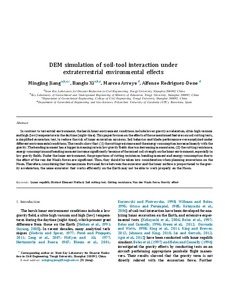Mostra el registre d'ítem simple
DEM simulation of soil-tool interaction under extraterrestrial environmental effects
| dc.contributor.author | Jiang, Mingjing |
| dc.contributor.author | Xi, Banglu |
| dc.contributor.author | Arroyo Alvarez de Toledo, Marcos |
| dc.contributor.author | Rodríguez Dono, Alfonso |
| dc.contributor.other | Universitat Politècnica de Catalunya. Departament d'Enginyeria Civil i Ambiental |
| dc.date.accessioned | 2017-02-21T19:26:44Z |
| dc.date.available | 2019-07-01T08:05:18Z |
| dc.date.issued | 2017-06 |
| dc.identifier.citation | Jiang, M., Xi, B., Arroyo, M., Rodriguez-Dono, A. DEM simulation of soil-tool interaction under extraterrestrial environmental effects. "Journal of terramechanics", Juny 2017, vol. 71, p. 1-13. |
| dc.identifier.issn | 0022-4898 |
| dc.identifier.other | http://arxiv.org/abs/1903.04821 |
| dc.identifier.uri | http://hdl.handle.net/2117/101355 |
| dc.description.abstract | In contrast to terrestrial environment, the harsh lunar environment conditions include lower gravity acceleration, ultra-high vacuum and high (low) temperature in the daytime (night-time). This paper focuses on the effects of those mentioned features on soil cutting tests, a simplified excavation test, to reduce the risk of lunar excavation missions. Soil behavior and blade performance were analyzed under different environmental conditions. The results show that: (1) the cutting resistance and the energy consumption increase linearly with the gravity. The bending moment has a bigger increasing rate in low gravity fields due to a decreasing moment arm; (2) the cutting resistance, energy consumption and bending moment increase significantly because of the raised soil strength on the lunar environment, especially in low gravity fields. Under the lunar environment, the proportions of cutting resistance, bending moment and energy consumption due to the effect of the van der Waals forces are significant. Thus, they should be taken into consideration when planning excavations on the Moon. Therefore, considering that the maximum frictional force between the excavator and the lunar surface is proportional to the gravity acceleration, the same excavator that works efficiently on the Earth may not be able to work properly on the Moon. |
| dc.format.extent | 13 p. |
| dc.language.iso | eng |
| dc.rights.uri | http://creativecommons.org/licenses/by-nc-nd/3.0/es/ |
| dc.subject | Àrees temàtiques de la UPC::Enginyeria civil::Geotècnia::Mecànica de sòls |
| dc.subject.lcsh | Lunar soil |
| dc.subject.other | Lunar regolith |
| dc.subject.other | Distinct Element Method |
| dc.subject.other | Soil cutting test |
| dc.subject.other | Cutting resistance |
| dc.subject.other | Van der Waals force |
| dc.subject.other | Gravity effect |
| dc.title | DEM simulation of soil-tool interaction under extraterrestrial environmental effects |
| dc.type | Article |
| dc.subject.lemac | Lluna -- Exploració |
| dc.identifier.doi | 10.1016/j.jterra.2017.01.002 |
| dc.description.peerreviewed | Peer Reviewed |
| dc.relation.publisherversion | http://www.sciencedirect.com/science/article/pii/S0022489817300083 |
| dc.rights.access | Open Access |
| local.identifier.drac | 19707936 |
| dc.description.version | Postprint (author's final draft) |
| dc.relation.projectid | info:eu-repo/grantAgreement/EC/H2020/645665/EU/Geohazards: Risk Assessment, Mitigation and Prevention/GEO-RAMP |
| local.citation.author | Jiang, M.; Xi, B.; Arroyo, M.; Rodriguez-Dono, A. |
| local.citation.publicationName | Journal of terramechanics |
| local.citation.volume | 71 |
| local.citation.startingPage | 1 |
| local.citation.endingPage | 13 |
Fitxers d'aquest items
Aquest ítem apareix a les col·leccions següents
-
Articles de revista [3.026]


